Ocular Drug Delivery Market Research, 2032
The global ocular drug delivery market size valued at $67.7 billion in 2022, and is projected to reach $115.5 billion by 2032, growing at a CAGR of 5.5% from 2023 to 2032. The ocular drug delivery market growth is driven by advancement in ocular drug delivery technology, surge in ageing population, and rise in awareness about the various eye disorders. Aged population increases susceptibility to conditions such as age-related macular degeneration (AMD), cataracts, glaucoma, and diabetic retinopathy. For instance, according to AGS Health in Aging Foundation, 2023, about 20 percent of people aged 65 and older have cataract. Thus, as the global population continues to age, the prevalence of eye disorders is expected to rise, which in turn drives the demand for advanced ocular drug delivery technologies.
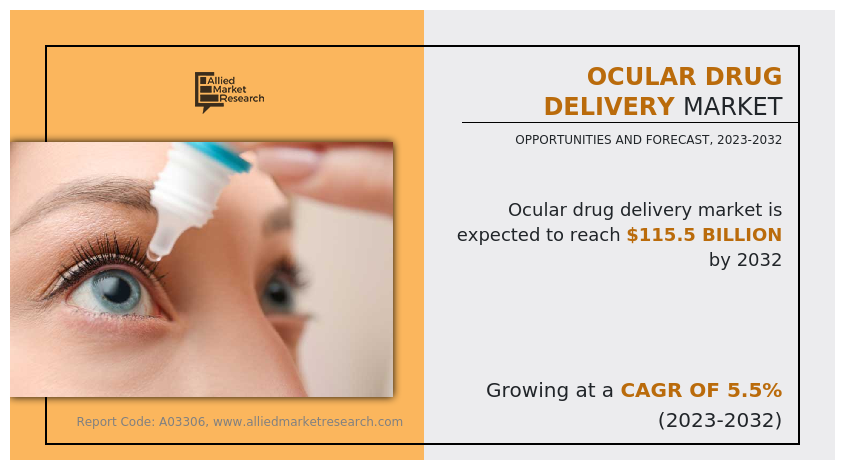
Key Takeaways
- By technology, the topical segment dominated the global market in 2022.
- By formulation type, the solution segment dominated the market in 2022.
- By disease indication, the age related macular degeneration segment dominated the global market in 2022.
- The North America region dominated the market in terms of revenue in 2022.
- Asia-Pacific region is expected to register the highest CAGR during the forecast period.
Ocular drug delivery is the process of delivering drugs to the eyes in order to treat different types of eye disorders such as diabetic retinopathy, dry eye syndrome, age-related macular degeneration, and others. This specialized delivery system aims to minimize systemic side effects while optimizing the therapeutic effects of medications by addressing the limitations of the ocular environment. Ocular drug delivery systems are designed to improve the drug delivery and effectively provide medications to the intended tissues inside the eye. Ocular drug delivery involves the use of a variety of techniques, such as implants, ointments, eye drops, injections, and contact lenses.
Market Dynamics
The ocular drug delivery market trends include increase in prevalence of eye diseases, strong product pipeline, and surge in product approvals. The rise in prevalence of eye disorders is a major driving factor in the growth of the ocular drug delivery market. Eye disorders are common diseases and have significant implications for healthcare systems and the demand for effective ocular drug delivery technologies. For instance, according to the World Health Organization (WHO) 2023, about 2.2 billion people across the globe have a distance or near vision impairment. In addition, according to Eye Health Statistics, more than 24.4 million Americans aged 40 years and older are suffering from cataract. Further, increase in access to diagnostic tests for conjunctivitis, rise in R&D activities by the market players, and surge in strategic collaborations among the market players are expected to drive the growth of the global market.
Furthermore, technological advancement in ocular drug delivery is a major driver for the ocular drug delivery market. Advanced techniques allow improved efficacy, safety, and convenience of administering drugs for the treatment of various eye conditions. For instance, development of sustained-release drug delivery systems such as intravitreal implants and drug-eluting contact lenses, provide a controlled and prolonged release of medication and improve patient outcomes. Thus, development of new technology formulations drives the market growth.
However, limited patient compliance and stringent regulatory guidelines for the new product approval restrain the growth of the ocular drug delivery market size. Stringent regulatory guidelines delays the market entry of new products and create barriers. Thus, strict and long regulatory approval processes hamper the growth of the ocular drug delivery market.
On the other hand, technological advancement in ocular drug delivery and increase in new product approvals are expected to create ocular drug delivery market opportunity for the market growth during the forecast period. For instance, the development of intravitreal injections and nanoparticles based drug delivery facilitates precise and controlled administration of drug at the site of action. In addition, sustained-release medications are the newly emerged technologies for the ocular drug delivery. For instance, Ozurdex (dexamethasone intravitreal implant) releases medication over an extended period directly into the vitreous cavity. Thus, development of advanced technology drug delivery systems is expected to create lucrative opportunities for the growth of the ocular drug delivery market during the forecast period.
The ongoing global economic recession influences several industries, including medical technology, and pharmaceuticals, which has an impact on the ocular drug delivery market. During a recession, the medical technology industry is moderately impacted due to increase in cost for supplies, and healthcare providers. Further, reduction in research funding is slowing down the development of new treatment and technologies. Despite these challenges, the ocular drug delivery market continues to experience moderate revenue growth owing to technological advancements in ocular drug delivery and increase in number of people seeking treatment for various eye disorders. Thus, the ocular drug delivery market is moderately impacted by the recession.
Segmental Overview
The ocular drug delivery market is segmented on the basis of technology, formulation type, disease indication, end user, and region. On the basis of technology, the market is classified into topical, ocular insert, intraocular implants, in-situ gels, and others. On the basis of formulation type, the market is categorized into solution, emulsion, suspension, ointment, and others. On the basis of disease indication, the market is segmented into glaucoma, diabetic retinopathy, dry eye syndrome, age related macular degeneration, and others. On the basis of end use the market is divided into hospitals, ophthalmic clinics, and others. Region-wise, the market is analyzed across North America (the U.S., Canada, and Mexico), Europe (Germany, France, the UK, Italy, Spain, and Rest of Europe), Asia-Pacific (China, Japan, Australia, India, South Korea, and Rest of Asia-Pacific), and LAMEA (Brazil, South Africa, Saudi Arabia, and Rest of LAMEA).
By Technology
The ocular drug delivery market is segmented into topical, ocular insert, intraocular implants, in-situ gels, and others. The topical segment daccounted for the largest ocular drug delivery market share in 2022 and is expected to remain dominant during the forecast period. This is attributed to easy availability, convenience, and affordability of topical medications. Further, surge in prevalence of dry eye syndrome has increased the demand for topical drug delivery products, which in turn drives the market growth.
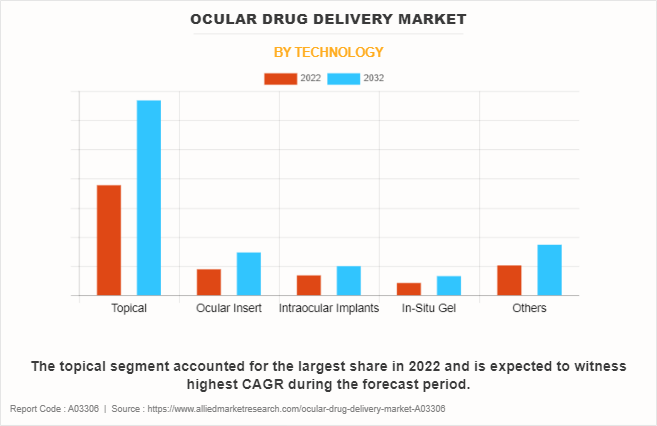
By Formulation
The ocular drug delivery market is segmented into topical, ocular insert, intraocular implants, in-situ gels, and others. The solution segment accounted for the largest ocular drug delivery market share in 2022 and is expected to be the fastest growing segment during the forecast period. This is attributed to availability of over-the-counter solutions for the treatment of various eye disorders.
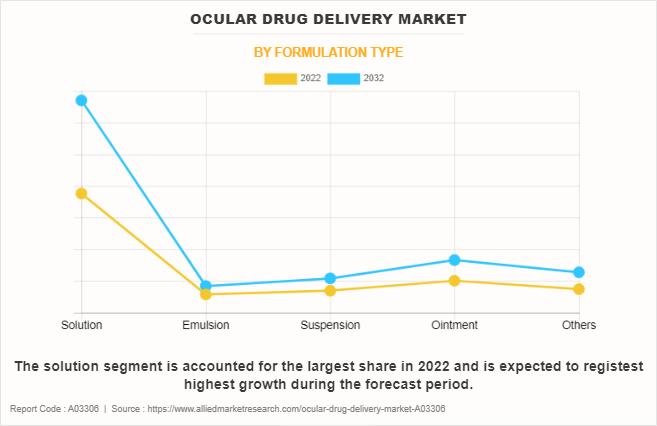
By Disease Indication
The ocular drug delivery market is divided into glaucoma, diabetic retinopathy, dry eye syndrome, age related macular degeneration, and others. The age related macular degeneration segment dominated the global market in 2022 and is anticipated to continue this trend during the forecast period, owing to high prevalence of increasing prevalence of age related macular degeneration. However, glaucoma segment is expected to register the highest CAGR during the ocular drug delivery market forecast period, owing to increasing number of people suffering from glaucoma.
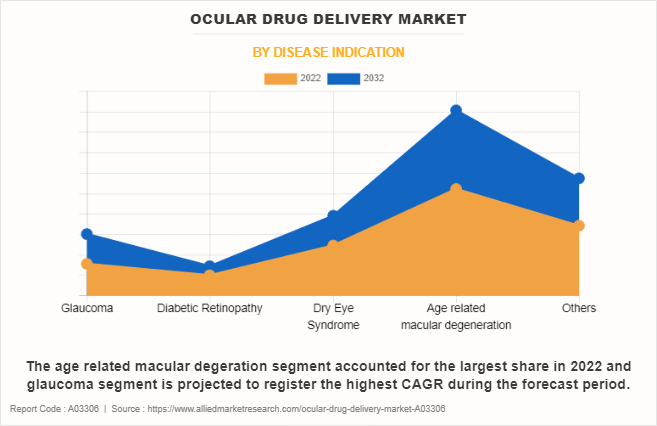
By End User
The ocular drug delivery industry is divided into hospitals, ophthalmic clinics, and others. The hospital segment dominated the global market in 2022. This is attributed to increase in awareness and treatment availability about eye diseases. However, others segment is expected to register fastest growth during the forecast period, owing increase in the treatment of eye disorders from ambulatory surgical centers.
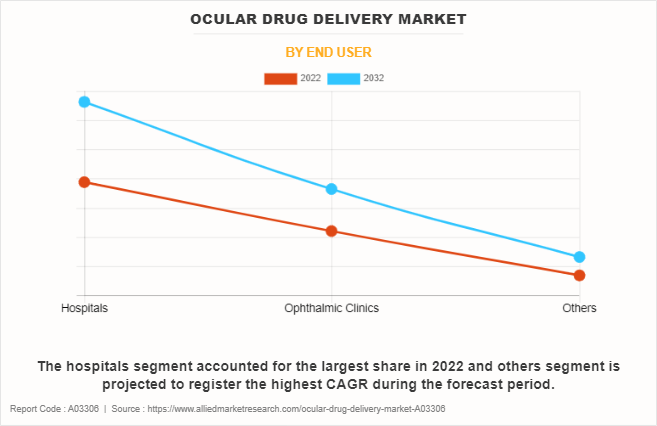
By Region
The ocular drug delivery industry is analyzed across North America, Europe, Asia-Pacific, and LAMEA. North America accounted for a major share of the ocular drug delivery market in 2022 and is expected to maintain its dominance during the forecast period. The presence of several major players, such as AbbVie Inc., EyePoint Pharmaceuticals, Inc., Clearside Biomedical, and Ocular Therapeutix, Inc. and the easy accessibility of medications in this region drives the growth of the market. In addition, surge in R&D activities boosts the market growth in this region.
Asia-Pacific is expected to grow at the highest rate during the forecast period. The market growth in this region is attributed to increase in prevalence of diabetic retinopathy and cataract and surge in ageing population. In addition, Asia-Pacific offers profitable opportunities for key players operating in the ocular drug delivery market, thereby registering the fastest growth rate during the forecast period, owing to the rise in disposable income as well as increase in healthcare expenditure, and development of pharmaceutical industry.
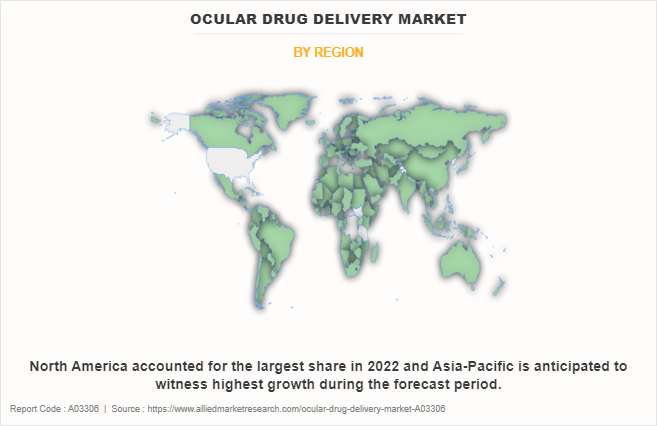
Competition Analysis
Competition analysis and profiles of the major players in the ocular drug delivery, include Ocular Therapeutix, Inc., EyePoint Pharmaceuticals, Inc., Clearside Biomedical, Santen Pharmaceutical Co., Ltd., Abbvie Inc., Novaliq GmbH, Bausch & Lomb, Alimera Sciences, Inc., Nicox, and Kiora Pharmaceuticals, Inc. Major players have adopted product approval, agreement, and partnership, as key developmental strategies to improve their product portfolio and gain strong foothold in the ocular drug delivery market.
Recent Product Approvals in the Ocular Drug Delivery Market
- In June 2023, Novaliq GmbH, a pharmaceutical company received the Food and Drug Adminstation (FDA), approval for its VEVYE an opthalmic solution for the treatment of dry eye disease. VEVYE is the first cyclosporine topical solution indicated for the treatment of dry eye
- In December 2021, AbbVie Inc., a global pharmaceutical company has received the Food and Drug Administration (FDA) approval for its VUITY eye drop. VUITY eye drop is the first and only approved formulation to treat age-related blurry near vision
Recent Collaboration in the Ocular Drug Delivery Market
- In October 2020, Ocular Therapeutix Inc., a global biopharmaceutical company has entered into a collaboration and agreement with AffaMed Therapeutics a clinical-stage biopharmaceutical company. Under this agreement AffaMed Therapeutics will develop and commercialize of DEXTENZA and OTX-TIC in Greater China, South Korea, and the ASEAN markets.
Key Benefits For Stakeholders
- This report provides a quantitative analysis of the market segments, current trends, estimations, and dynamics of the ocular drug delivery market analysis from 2022 to 2032 to identify the prevailing ocular drug delivery market opportunities.
- The market research is offered along with information related to key drivers, restraints, and opportunities.
- Porter's five forces analysis highlights the potency of buyers and suppliers to enable stakeholders make profit-oriented business decisions and strengthen their supplier-buyer network.
- In-depth analysis of the ocular drug delivery market segmentation assists to determine the prevailing market opportunities.
- Major countries in each region are mapped according to their revenue contribution to the global market.
- Market player positioning facilitates benchmarking and provides a clear understanding of the present position of the market players.
- The report includes the analysis of the regional as well as global ocular drug delivery market trends, key players, market segments, application areas, and market growth strategies.
Ocular Drug Delivery Market Report Highlights
| Aspects | Details |
| Market Size By 2032 | USD 115.5 billion |
| Growth Rate | CAGR of 5.5% |
| Forecast period | 2022 - 2032 |
| Report Pages | 248 |
| By Technology |
|
| By Formulation Type |
|
| By End User |
|
| By Disease Indication |
|
| By Region |
|
| Key Market Players | Alimera Sciences, Inc., AbbVie Inc., EyePoint Pharmaceuticals, Inc., Nocox, Bausch Health Companies, Inc., Ocular Therapeutix, Inc., Kiora Pharmaceuticals, Inc., Clearside Biomedical, Inc., Santen Pharmaceutical Co., Ltd., Novaliq GmbH |
Analyst Review
The growth of ocular drug delivery market is attributed to factors such as rise in new product approvals, surge in collaboration between market key players, and advancements in the drug delivery technologies. For instance, in June 2023, Novaliq GmbH, a pharmaceutical company has received the Food and Drug Adminstation (FDA), approval for its VEVYE an opthalmic solution for the treatment of dry eye disease. VEVYE is the first cyclosporine topical solution indicated for the treatment of dry eye.
Further, in October 2020, Ocular Therapeutix Inc., a global biopharmaceutical company has entered into a collaboration and agreement with AffaMed Therapeutics a clinical-stage biopharmaceutical company. Under this agreement AffaMed Therapeutics will develop and commercialize of DEXTENZA and OTX-TIC in Greater China, South Korea, and the ASEAN markets. This collaboration will help the company to expand its geographic reach of DEXTENZA and OTX-TIC. Thus, all aforementioned factors boost the growth of the ocular drug delivery market.
The market value of ocular drug delivery market in 2022 is $67,700.00 million.
The forecast period for ocular drug delivery market is 2023 to 2032.
The market value of ocular drug delivery market in 2032 is $115,541.65 million.
Ocular drug delivery is the process of delivering drugs to the eyes in order to treat different types of eye disorders such as diabetic retinopathy, dry eye syndrome, age-related macular degeneration, and others.
Asia-Pacific has the highest growth rate in the market which is growing due to the contribution of the following emerging countries such as China and India. This is due to development of pharmaceutical industries, surge in expenditures, and rise in prevalence of eye disorders.
The growth of the ocular drug delivery market is driven by increase in prevalence of eye diseases, strong product pipeline, and surge in product approvals.
The topical segment dominated the global market in 2022 and is expected to remain dominant during the forecast period. This is attributed to easy availability, convenience, and affordability of topical medications.
Top companies such as, Ocular Therapeutix, Inc., EyePoint Pharmaceuticals, Inc., Clearside Biomedical, Santen Pharmaceutical Co., Ltd., Abbvie Inc., Novaliq GmbH, Bausch & Lomb, Alimera Sciences, Inc., Nicox, and Kiora Pharmaceuticals, Inc. These key players held a high market postion owing to the strong geographical foothold in different regions.
The base year is 2022 in ocular drug delivery market.
Loading Table Of Content...
Loading Research Methodology...



